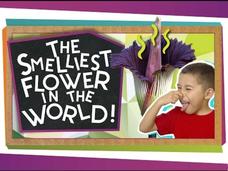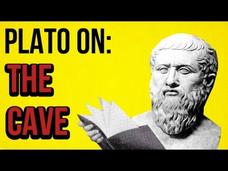Crash Course
The Sex Lives of Nonvascular Plants: Alternation of Generations
Plants evolved more than 400 million years ago into two types — vascular and nonvascular. Here's a video that explains the difference between vascular and nonvascular plants and then focuses on the over 24,000 types of nonvascular...
Crash Course
Vascular Plants = Winning!
Viewers explore vascular plants with a video that shows their different tissues, their ability to grow taller and wider, and their parts. Young scientists then see these plants xylem and phloem and learn how vascular plants move...
Be Smart
Do Plants Think?
Plants react to many different stimuli, but do they think? After many years, scientists now have a definite answer. A video shares the theories and facts as part of a larger biology playlist. From plants listening to music to plants...
Crash Course
The Plants and the Bees: Plant Reproduction
This video explains the difference between gametophytes and sporophytes and uses this this information to teach the reproduction process of various vascular plants. Viewers see how ferns, gymnosperms, and angiosperms reproduce.
FuseSchool
Transport in Plants, Part 1: Xylem and Phloem
Humans use their hearts and circulatory systems to move things through their bodies, but plants also have a transport system. The first video in a three-part series introduces the xylem and phloem. It explains what each part moves, which...
Crash Course
Plant Cells
Why can't plants escape prison? Because their cells were surrounded by walls. Introduce viewers to the evolution of plants with a video that discusses the differences between prokaryotic and eukaryotic cells, plant cells' organelles, and...
PBS
Toward a Smarter Grid
Did you realize that the latest innovations in technology get their electrical power from a system that's 100 years old? Help pupils make sense of the power grid using a short video and related questions. The lesson, part of NOVA's...
Fuse School
Quarrying - Economic, Environmental and Social Effects
Where does limestone actually come from? The sixth video in a seven-part series introduces pupils to the quandary of quarrying. The resource examines the positive economic factors involved in digging for limestone, as well as the...
SciShow Kids
Excellent Evergreens
Evergreens are green all year long. But why? Watch a video that explains the science behind the evergreen and other coniferoous plants.
Be Smart
The Surprising Origin of Thanksgiving Foods
Many of the foods pilgrims ate include foods people still eat at American Thanksgiving celebrations today. The turkey, a domesticated animal native to the Americas, often finds itself the center of attention on this holiday. Today's corn...
Deep Look
These Termites Turn Your House into a Palace of Poop
Everyone knows that termites are bad news for the wooden parts of a home. How do they do it, and how can we stop them? Go inside a termite (literally) to discover the scores of bacteria and protists that help make wood taste good. The...
SciShow
Wasp Nests and Bee Hives
It turns out that wasps and bees have a lot more in common that the word ouch! Junior entomologists explore the similarities and differences between flying, stinging insects with the 136th installment in a 143-part series of science...
FuseSchool
What Are Chromosomes?
Two meters worth of DNA fits into a cell that is only two micrometers wide thanks to chromosomes. A video, part of a Fuse School Biology playlist, explains what chromosomes are and how they work. It describes where they are found and how...
Teacher's Pet
Unique Features of Plant Cells
In plants, vacuoles take up most of the space in a cell. The video explains what vacuoles are and their importance. It also discusses the function of the cell wall and plastids, both unique features of plant cells.
Ricochet Science
Classification of Life
Animal, vegetable, or mineral? The second installment of a five-part video series focuses on the classification of life. The video briefly covers the taxonomic levels and then applies the classification to humans. The video also...
Nature League
What Are Adaptations? - Lesson Plan
Texas short-horned lizards shoot blood out of their eyes to deter predators. The unique adaption allows them to thrive in a hostile environment. Pupils learn more about this and other adaptations of plants, animals, and humans in the...
Howard Hughes Medical Institute
The Day the Mesozoic Died
A dynamic, three-part feature explores what caused mass extinction of the dinosaurs at the end of the Cretaceous period. Computer animations, interviews, and on-site footage from around the world divulge evidence that it was the K-T...
SciShow Kids
The World's Smelliest Flower
The Corpse Flower gets its name honestly, as it smells like a corpse. But why do some flowers smell good and some smell bad? Watch a video that explains the science around flower scents.
The School of Life
Plato On: The Allegory of the Cave
What would you say if someone told you that your dreams and goals are merely phantoms in your own mind? A video analysis of Plato's "Allegory of the Cave" from The Republic takes high schoolers through the famous metaphor,...
Khan Academy
First Living Things on Land Clarification, Cosmology and Astronomy
Sal clarifies concepts covered in the Khan Academy video on Biodiversity in the Phanerozoic Eon. He explains the types of animals and plants that were the first life forms on land. Additionally, he describes what these organisms would...
Crash Course
Community Ecology II: Predators
The first examples of mimicry we have found date back to before flowering plants. The video goes in depth on predators at the community ecology level. It includes discussions of herbivores, parasitism, adaptations, cryptic coloration,...
MinuteEarth
Invasion of the Yellow Crazy Ants!
How much does an invasive species really matter? The video focuses on examples of accidental species spread as well as intentional introductions. It highlights the problems caused by spreading new plants and animals to areas with no...
FuseSchool
Intro to Cells: Animal, Plant, Nerve and Red Blood Cells
Throw your dendrites in the air and wave 'em like you just don't care! An excellent video in the Fuse School playlist explains the parts and functions of cells. It describes their structures, functions, and specialties.
Crash Course
Great Glands - Your Endocrine System
Diabetes is the most common endocrine disorder in the United States, affecting about eight percent of the total population. The working parts of the endocrine system are examined in a video that demonstrates how cells receive...























